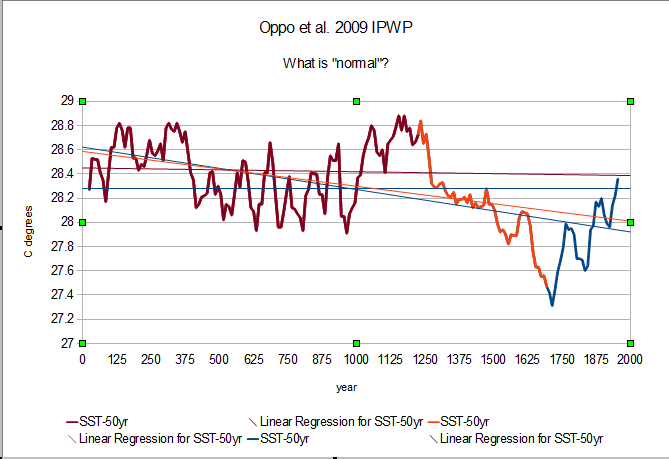I love when the conversation turns to clouds and whether they are a positive or negative feedback. Clouds are both. Whether they are a "net" positive or negative feedback depends on where they change. Since they are not "fixed" I doubt there is any definitive proof they are anything other than a regulating variable since they can swing both ways.
At higher latitudes clouds are most likely positive feedbacks. Winter clouds tend to let the cloud covered region get less cold. In the tropics, clouds tend to keep areas from getting too warm. The battle ground should be the mid latitudes.
Since most of the energy absorbed is in the tropics, knowing how well the tropics correlated with "global" temperature would be a good thing to know so that you can get a feel for how much "weight" to place on the "regional" responses. With the exception of the 21st century, the "Global" temperature have followed tropical temperatures extremely closely. Now it would be nice to just compare changes with cloud cover with changes in tropical temperature right?
Nope, the cloud fraction data sucks the big one. Since that data sucks so bad you are stuck with "modeling". You can use a super doper state of the art climate model or you can infer cloud response based on logic. Both are models since you are only going to get some inferred answer, the logic just cost less.
Logic: Since warmer air can hold more moisture than colder air, all things remaining equal, there would be an increase in clouds with ocean warming. If clouds were "only" a positive feedback to surface warming, the system would be unstable and run away. Simple right. You can infer clouds must have some regulation effect on tropical climate or there would be no tropical oceans. They would have boiled away or be frozen.
That logic obviously has limits. There is more to the globe than the tropics and there is and has been warming in the tropics. Could it be we have reached a tipping point that will change millions of years worth of semi-stable temperatures?
This is where paleo data could come in handy.
I use this Oppo et al. Indo-Pacific Warm Pool quite often because it agrees well with the tropical oceans which agree well with "global" temperatures and is backed by the simple logic that the oceans wag the tail. So provided the IPWP does "teleconnect" with "global" climate, things look pretty "normal". There was a cooler period that Earth is recovering from and now she is back into her happy zone. There are absolutely no guarantees that is the case, just evidence that it could be.
Since "global" climate follows tropical oceans so closely except for that little 21st century glitch, there probably isn't much more to worry about in the tropics.
If I use the not so elaborately interpolated GISS data, the 250km version instead of the 1200km version, there isn't any glitch to be concerned about. Climate suddenly gets a lot more simple. The tropical oceans have been warming for the past 300 years to recover from the little ice age and now thing are back to "normal" for the past 2000 years. CO2 has some impact but likely not anywhere near as much as advertised. That would imply clouds/water vapor are not as strong a positive feedback as estimated.
Well, simple, really doesn't cut it in climate science. There are a lot of positions to fill and mouths to feed so complexity leads to full employment and happy productive climate scientists.
That means "adjustments" will be in order. Steven Sherwood, the great "adjuster", has a paper that explains what is required to keep climate scary enough for climate scientists to help save the world from itself. Part of the "adjustments" is removing or managing ENSO variability and volcanic "semi-direct" effects so that the monstrous CO2 signal can be teased out of the "noise". Then, clouds will be a net positive feedback and water vapor will drive climate higher and we will finally see the ominous TROPICAL TROPOSPHERIC HOT SPOT! Then finally, it will be "worse than we thought".
Think just for a second. If the tropical oceans "drive" global climate, and ENSO is a feather of the tropical oceans, why in the hell would you want to remove the climate driver? Because it is inconvenient. Natural variability (read ENSO) cannot POSSIBILITY be more than a tiny fraction of climate because my complex models told me so. According to a few trees in California and Russia, that Oppo et al. reconstruction has to be total crap because climate never varied one bit until this past half century once we got the surface stations tuned and adjusted to fit the models that are tuned and adjusted to match our theory that CO2 is tuning and adjusting climate. Can't you thick headed, Neanderthal, deniers get it that we are "climate scientists" and know what we are doing!!
Frankly, no.
Added; In case you are wondering, there is a 94.2% correlation between annual ERSSTv3b tropical SST and GISS 250km "global" temperatures. The tropical oceans are about 44% of the global area. The 11 yr average difference between the two is +/-0.1 and close to +0.2/-2.8 annually. While long range interpolation does produce a more accurate "global" average temperature it doesn't produce a more accuarte "global" average energy due to very low temperature anomalies having the same "weight" as much higher energy tropical anomalies.



No comments:
Post a Comment